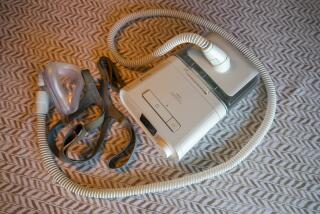A Portable Breath of Life : New Technology in Oxygen Tanks Gives Added Mobility to People With Breathing Problems
- Share via
Two years ago, Robert Beals of San Clemente realized that it was time to get serious about his health. Since then, he has quit smoking, developed a regular exercise habit and started using supplemental oxygen. “They gave me a choice,” he says. “I could extend and improve the quality of my life, or I could just keep going the way I was.
“So it really wasn’t hard to choose.”
Beals, 74, has had lung problems since he was a child. “I had double pneumonia on two occasions, and I’ve been a little bit short of breath ever since,” he says. From the time he was a teen-ager, he compounded the problem by smoking.
Emphysema, a chronic lung disease most often brought on by smoking, began to slow him down about 10 years ago. He tired more easily, became short of breath more often. But he kept going, traveling frequently to the Far East on business. It was on one of those trips that he finally became so ill he needed oxygen on the flight home.
“I’d had a flu bug before I left, but on the trip it just kept getting worse. When I got back, I had lost a lot of weight and I had pneumonia. After that, my doctors suggested I go on oxygen full time,” Beals says.
Now Beals feels better than he has in years.
Although he prefers not to schedule his workouts, he makes sure he gets in exercise sessions about three times a week. Some days, he walks along the shore near Dana Point Harbor. Other times, particularly when the air is smoggy, he moves indoors to walk at the Mission Viejo or Laguna Hills malls. Or he stays home and rides his exercise bike.
And if he happens to be in Singapore or Thailand or Taiwan or any of the other places he visits frequently as a manufacturer’s representative, he does his walking there, carrying a small portable oxygen tank in an over-the-shoulder carrying case.
When Beals first began using oxygen, he wasn’t quite so mobile. Although he soon felt well enough to exercise, he was encumbered by a tank so big and heavy he had to pull it along on a cart. It was a nuisance, especially for activities such as going to the beach--the cart didn’t move so well in the sand.
And people stared. Beals says he still gets odd looks now and then from strangers who notice the nasal cannula that connects him to the portable tank, “But when that happens, I just smile, and they usually smile back.”
Although supplemental oxygen has proven its worth in numerous studies over the past decade or so, many of those who could benefit from it are reluctant to use it.
Dr. Paul Selecky, a pulmonary specialist at Hoag Hospital in Newport Beach and president of the American Lung Assn.’s Orange County chapter, understands those apprehensions.
“It’s a visible change,” he says. “People see them with the oxygen cannula in their nose, and suddenly their personal life has become public.”
Although going on oxygen may feel like taking a step down in terms of health, it’s more likely to be a step up, Selecky says. “This has set many patients free, and allowed them to do things they wouldn’t have been able to do before. They can travel, they can get involved in exercise programs. And new technologies have allowed this to be done more and more efficiently.”
Selecky recalls one patient, formerly an avid skier, whose illness kept him from hitting the slopes. “The combination of exertion and the higher altitude made it impossible for him. But with the use of a small oxygen tank he was able to carry in a little backpack, he started skiing again,” Selecky says.
Over the past several years, oxygen tanks have become smaller and lighter, Selecky says. And with battery-powered electronic delivery devices that only release the gas when the user is inhaling, the supply also lasts longer.
Beals uses a system called Vagabond, made by Anaheim-based XEBEK International. XEBEK President John Dooley says he got the idea to make smaller, lighter oxygen tanks several years ago when his 80-year-old mother-in-law began using oxygen because of heart and respiratory problems.
“The cylinder she had to use was so big you’d need to be 6-foot-4 and weigh 220 pounds to carry it. And she weighs about 85 pounds soaking wet. When I saw that, I said, ‘Wait a minute--there’s got to be an easier way to do this.’ ”
So using fiberglass composite materials that were originally developed for NASA rocket motor casings, XEBEK developed a smaller, lighter cylinder. “Our system weighs less than 5 pounds, and lasts an average of about 12 hours.”
XEBEK has also developed an even smaller system for children.
Older patients suffering from chronic obstructive pulmonary diseases (COPD) such as emphysema and chronic bronchitis are the ones most likely to need extra oxygen, Selecky says, although not all such patients do. The deciding factor is an analysis of arterial blood gases. If the level of oxygen is below a certain level, then the patient may need to be breathing in more oxygen than is available in the atmosphere, about 21%.
Some patients may need oxygen full time, while others don’t. “There are patients with significant lung disease or heart disease who may have adequate levels (of oxygen) at rest. But their lungs can’t keep up when they get physically active. Similarly, there are patients whose oxygen only drops below that critical level during sleep.”
Other COPD patients may not need help except at higher altitudes, or in airplanes, where the pressurized air is roughly equivalent to that on an 8,000-foot mountain peak.
“Every airline has a different policy about oxygen,” Selecky says. “Some don’t provide it at all, and others will if you order it ahead of time. But they’re not required to provide it.”
Beals, who spends a lot of time on airplanes, hasn’t had trouble getting the airlines he deals with to provide oxygen. But he’d rather just take along his own tank. “They won’t let me do that,” he says. “I can take it in my checked baggage, but only if it’s empty. So when I get there, I have to go to a hospital or someplace and get it filled.”
Oxygen isn’t an explosive gas, but it does support combustion and should not be used around open flames. Still, airlines and some cruise ship lines are wary about letting their passengers bring it on board.
“We’ve been working with the airlines to get them to use our system,” Dooley says. It’s absolutely safe to use and transport. Obviously you don’t want to be throwing it around like a basketball, but if somebody bumps it, there’s no problem.”
More to Read
Sign up for Essential California
The most important California stories and recommendations in your inbox every morning.
You may occasionally receive promotional content from the Los Angeles Times.










